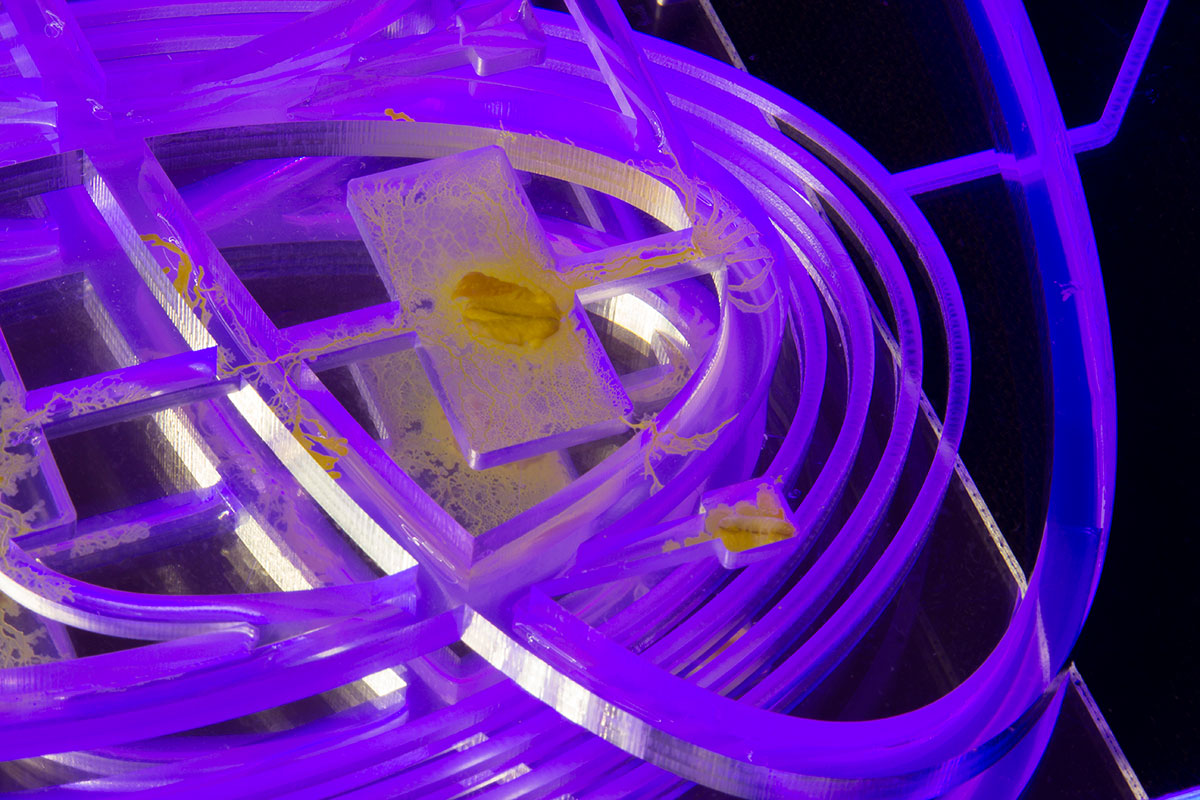ART CITIES: Munich-Jenna Sutela
 Jenna Sutela works with living organisms such as bacteria and slime mold as well as with sound and language. In her audiovisual works, sculptures, and performances, the artist creates connections between biological entities and technologies. Her particular interest is in the productive interaction between human and non-human organisms. In her work “nimiia cétii” for example, she created a novel written language whose machine-generated characters are based on capturing and copying the movements of Bacillus subtilis natto*.
Jenna Sutela works with living organisms such as bacteria and slime mold as well as with sound and language. In her audiovisual works, sculptures, and performances, the artist creates connections between biological entities and technologies. Her particular interest is in the productive interaction between human and non-human organisms. In her work “nimiia cétii” for example, she created a novel written language whose machine-generated characters are based on capturing and copying the movements of Bacillus subtilis natto*.
By Dimitris Lempesis
Photo: Haus der Kunst Archive
Drawing on cutting-edge scientific research and its philosophical implications, Jenna Sutela’s work is often processual in nature. In her projects, wetware, a term used to consider organic matter through the lens of computing – hardware and software, are used to explore the world beyond human perception. The work “HMO Nutrix” (2022) deals with a bodily product that has amazing superpowers: human milk. In her research-based work, Sutela explores both the symbiosis of humans and microorganisms and the efforts of the food industry to biotechnologically reproduce the ingredients of breast milk and market them as part of a new generation of health-optimizing dietary supplements. At the “HMO Nutrix” (2022) synthetically produced human milk is staged as a bubbling fountain. The bubbles are generated by breast pumps stirring up liquids while the installation is animated by biomimetic throat singing. The solution is enriched with substances that researchers have identified as key ingredients of breast milk. While so-called human milk oligosaccharides (HMOs) are known to be indigestible by infants, they feed their gut bacteria: they not only protect newborns against diseases but also promote their cognitive development and are essential for building their microbiomes. In her poetically narrated film “Milky Ways,” Sutela combines the latest scientific insights with the myth of the creation of the Milky Way from the squirting breast milk of the goddess Hera. While the Greek goddess is creating the galaxy, breast milk is helping create a microbial universe inside the child’s body. In considering breastfeeding and how our symbiotic microbial culture expands the limits of consciousness, Sutela depicts human bodies as interconnected, interdependent environments through which other organisms and nutrients can move. The artist, therefore, suggests a universal commonality among and between species.
* Bacillus subtilis natto was found by Dr. Sawamura in 1906 and named Bacillus natto Sawamura. Since then it obtained the approvals for the manufacture of drug medicine in 1968, for animal drug in 1990, and for dietary additive in 1996, and it is now attracting attention as it has lately started being used for health food.
Photo: Jenna Sutela, From Hierarchy to Holarchy, 2017, © Jenna Sutela, Photo: Mikko Gaestel
Info: Curator: Sarah Johanna Theurer, Haus der Kunst, Prinzregentenstraße 1, Munich, Germany, Duration: 30/7-29/8/2022, Days & Hours: Mon, Wed & Fri-sun 10:00-20:00, Thu 10:00-22:00, www.hausderkunst.de/



Right: Jenna Sutela, Many-Headed Reading, 2016, © Jenna Sutela
